#332nd Fighter Group
Explore tagged Tumblr posts
Text

Tuskegee Airmen from the 332nd FG photographed in Aug 1944 at Ramitelli Airfield , Italy
#Tuskegee Airmen#332nd Fighter Group#100th Fighter Squadron#Fighter Pilot#P-51 Pilot#Army Air Forces#P-51#Red Tails#WW2#Ramitelli airfield#Aviation#History#Pilots#warbird
342 notes
·
View notes
Text

Alex Jefferson ❤️🫡
41 notes
·
View notes
Text

Marcelius Smith (L) and Roscoe Brown (R) of the 332nd Fighter Group work on the engine of a P-51 at Ramitelli, Italy, March 1945
104 notes
·
View notes
Text

Paul Adams 1920-2013, joined the Tuskegee Airmen shortly after graduating from South Carolina State University. He flew with the 332nd Fighter Squadron (the famed "Red Tails") throughout WWII. He would retire from the military in 1962. He then would become a teaching in the Lincoln (NE) public school system. They named Adams Elementary school for him in 2008.
Paul Adams and his fellow Tuskegee Airmen were the first African-American aviators in the U.S. military, whose distinguished record many historians credit with helping pave the way for the civil rights movement.
The group set an unprecedented record, flying more than 1,500 missions in Europe and North Africa. Adam served in nine major campaigns and received the Commendation Medal with three Oak Leaf clusters, each of which signifies subsequent bestowals of the same honor.
Doane College recognized him with the President's Honor of Distinction Award the same year. In 2007, he received the Congressional Gold Medal along with other Tuskegee Airmen, who were known as "guardian angels" by white airmen who were escorted by the African-American pilots during the war. Adams received a bronze replica at a ceremony in Lincoln. Doane College recognized him with the President's Honor of Distinction Award the same year.
And two years later, Adams, at President Barack Obama's invitation, attended the inauguration of the first black president along with other Tuskegee Airmen. Adams went on to become one of the first black teachers in LPS, and in 2008, his accomplishments were honored when the district named a new school after him.
He became a frequent visitor at Adams Elementary, where books about Tuskegee Airmen fill the library and teachers make a point to read them to students. The history became an integral part of Adams Elementary school
#black tumblr#black history#black literature#black excellence#black community#civil rights#black history is american history#blackexcellence365#tuskegee airmen#american history
244 notes
·
View notes
Text
If you’re wanting to watch Band of Brothers/The Pacific/Masters of the Air in chronological order with BoB 1st Currahee episode split up in the dates on screen I made a list
(Updated: April 12, 2024 7:58pm pst)
July, 10 1942 Easy Company Trains in Camp Tocca (Band of Brothers Ep. 1 Currahee 2001) August 7, 1942, Allied forces land on Guadalcanal (The Pacific Ep. 1 Guadalcanal/Leckie 2010) September 18, 1942, 7th Marines Land on Guadalcanal (The Pacific Ep. 2 Basilone 2010) December 1942 The 1st Marine Division on Guadalcanal is relieved (The Pacific Ep. 3 Melbourne 2010) *June 23, 1943, Easy Company Trains in Camp Mackall N.C. (Band of Brothers Ep. 1 Currahee) * June 25, 1943, 100th Bomb Group flew its first 8th Air Force combat mission (Master of the Air Ep. 1 2024)
July 16, 1943 the 100th Bomb Group bombed U-Boats in Tronbhdim (Masters of the Air Ep.2 2024) August 17, 1943 the 4th Bomb Wing of the 100th Bomb Group bombed Regenberg (Masters of the Air Ep. 3 2024) *September 6, 1943, Easy Company Boards transport ship in Brooklyn Naval Yard (Band of Brothers Ep. 1 Currahee)* September 16, 1943, William Quinn and Charles Bailey leave Belgium (Masters of the Air Ep.4 2024) September 18, 1943 -*East Company trains in Aldbourne, England (Band of Brothers Ep. 1 Currahee)* -John 'Bucky' Egan returns from leave to join the mission to bomb Munster (Master of the Air Ep.5 2024) October 14, 1943, John ‘Bucky’ Egan interrogated at Dulag Lut, Frankfurt Germany (Masters of the Air Ep. 6 2024) December 26, 1943, 1st Marine Division lands on Cape Gloucester (The Pacific Ep. 4 Gloucester/Pavuvu/Banika 2010) March 7, 1944, Stalag Luft III Sagan, Germany, Germans find the concealed radio Bucky was using to learn news of the War (Master of the Air Ep.7 2024) *June 4, 1944, D-Day Invasion postponed (Band of Brothers Ep. 1 Currahee)* *June 5, 1944 Easy Company Boards air transport planes bound for Normandy (Band of Brothers Ep. 1 Currahee)* June 6, 1944, 00:48 & 01:40 First airborne troops begin to land on Normandy (Band of Brothers Ep. 2 Day of Days 2001)
June, 7 1944 Easy Company Takes Carentan (Band of Brothers 3x10 Carentan)
August 12, 1944, The 332nd Fighter Group attack Radar stations in Southern France (Masters of the Air Ep.8 2024)
September 15, 1944 U.S. Marines landed on Peleliu at 08:32, on September 15, 1944 (the Pacific Part Five: Peleliu Landing)
September 16, 1944 Marines take Peleliu airfield (the Pacific Part Six: Airfield)
September, 17 1944 Operation Market Garden -(Band of Brothers 4x10 Replacements)
October 22/23, 1944, 2100 – 0200 Operation Pegasus (Band of Brothers 5x10 Crossroads)
October, 1944 Battle of Peleliu continues (the Pacific Part Seven: Peleliu Hills)
December 16, 1944 Battle of the Bulge (Band of Brothers 6x10 Bastogne)
January, 1945 Battle of Foy (Band of Brothers 7x10 The Breaking Point)
February 14, 1945 David Webb rejoins the 506th in Haguenau (Band of Brothers 8x10 The Last Patrol)
April 5, 1945 506th Finds abandoned Concentration Camp
(Band of Brothers 9x10 Why We Fight 2001)
April 1-June 22, 1945 Battle of Okinawa (The Pacific Part Nine: Okinawa)
May 7, 1945, Germany Surrenders V-E Day - (Master of the Air Ep. 9 2024) - (Band of Brothers 10x10 Points 2001)
August 15 The Empire of Japan surrenders end of the War (The Pacific Part Ten: Home)
257 notes
·
View notes
Text

Tuskegee Airmen 15th Air Force, 332nd Fighter Group, 100th Fighter Squadron
112 notes
·
View notes
Text

Tuskegee Airman General Benjamin Oliver Davis Jr. (December 18, 1912 – July 4, 2002) followed in the footsteps of his trail-blazing father as the first African American general in the Air Force. He was born in DC, and fully committed to a military career. He entered West Point Military Academy in 1932 and graduated thirty-fifth out of a class of 276 in 1936. After graduating from the Academy he was assigned to the 24th Regiment then stationed at Fort Benning, Georgia.
At a time when there were serious doubts that African Americans had the mental capacity to fly airplanes, he joined a small number of African Americans in the first flying training program for African Americans at Tuskegee. His pace-setting achievements led him to command the famed 99th Pursuit Squadron and the 332nd Fighter Group in WWII. Beginning as an unwelcome addition to the Air Force, African American pilots under the leadership of Colonel Davis established an enviable record of flying 15,000 sorties, shooting down 111 enemy planes, and destroying or damaging 273 aircraft on the ground. White bomber pilots who once shunned the African American fighter group as escorts quickly had a change of heart. The 332nd Fighter Group never lost a single escorted bomber in the group’s 200 missions.
He was awarded the Silver Star and Distinguished Flying Cross following WWII and served at the Pentagon and in several overseas posts. In the Korean Conflict, he commanded the 51st Fighter-Interceptor Wing and flew an F-86. In May 1965, he was promoted to the rank of Lieutenant General. He retired in 1970 after 37 years of military service. In 1998, President Bill Clinton awarded him with a fourth star raising him to the rank of full general. #africanhistory365 #africanexcellence
12 notes
·
View notes
Text

P-51D "Lollipop II" of the 332nd Fighter Group, Fossia, Italy. WWII
15 notes
·
View notes
Text


Lee "Buddy" Archer was a decorated Tuskegee Airman and World War II fighter pilot, known for his skill and bravery. Born on September 6, 1919, in Yonkers, New York, Archer broke barriers by joining the U.S. Army Air Corps and becoming one of the first Black aviators trained at Tuskegee Army Airfield. Serving with the 332nd Fighter Group, the legendary "Red Tails," Archer flew 169 combat missions in Europe.
On October 12, 1944, he secured three confirmed aerial victories in a single mission, making him one of the Tuskegee Airmen’s top aces. Archer received the Distinguished Flying Cross and later a Congressional Gold Medal for his contributions. After retiring from the military, he succeeded in business, becoming a General Foods vice president. Archer passed away in 2010, leaving a legacy of courage and excellence.
#blackexcellence#blackunity#redtails#buddyleearcher#tuskegee airmen#blackpower#blackhistory#TuskegeeAirmen#BlackHistory#WWIIFighterPilot#RedTails#BlackAviators#HeroicLegacy
8 notes
·
View notes
Text

Day 19 of 366 Days of Black History...
Many of the original Tuskegee Airmen went on to further pursue careers within the military. This Is What You Need To Know About The Tuskegee Airmen. #PushBlackHistory 👇🏿
✈️ Active from 1940-48, Black pilots were trained at Tuskegee University to get the chance to serve in WWII.
✈️ The Tuskegee Experiment trained nearly 14,00 specialists plus 1,000 pilots. After the persistence of black newspapers like the Chicago Defender and Pittsburgh Courier and the NAACP, FDR began to consider using black pilots in the segregated air force.
✈️ Known for their red-tailed fighter planes, the Tuskegee Airmen were composed of the 99th Pursuit Squadron, 332nd Fighter Group, and the 477th Bombardment Group of the United States Army Air Forces.
✈️ Pilots were truly badasses. They fought in Italy, North Africa, Austria and Germany often with hand me down planes.
✈️ Tuskegee Airmen had a higher success rate than their white counterparts. The 99th shot down 12 German fighters in two days and out of the more than 200 escorts they only lost 25 bombers compared to 46 by the 15th pilot groups.
20 notes
·
View notes
Photo
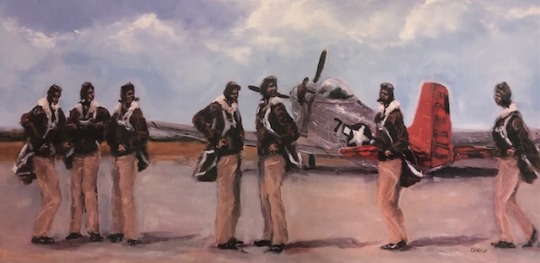
During World War II, around 1,000 Black pilots were trained at the Tuskegee Institute in Alabama to be a part of the U.S. Army Air Corps. It was the first time the U.S. had opened its doors to Black pilots. This print entitled 'The Lonely Angels' is of the famous Tuskegee Airmen of the 332nd Fighter Group, also known as the Red Tail Bombers. They were responsible for escorting and protecting American bombers from German fighter planes, and had one of the lowest loss records of any escort flying group.
#Black History Month#Black History#Tuskegee Airmen#Red Tail Bombers#The Lonely Angels#WWII#Pilots#American History
165 notes
·
View notes
Text
On February 19, 1942, the #TuskegeeAirmen made history as the first African American pilots who fought in World War II in the 1940s and maintaining the aircrafts.
Officially known as the 332nd Fighter Group and the 477th Bombardment Group of the United States Army Air Corps, the group was subjected to segregation and discrimination during their time in the army despite being as brave in fighting enemies as the rest of the military. Meanwhile, racism in America was still very much alive through Jim Crow laws.

16 notes
·
View notes
Text

A recently recaptured P-47D formerly of the 332nd Fighter Group at Göttingen, 1945
70 notes
·
View notes
Text

A Life of Dedicated Service: Remembering Brigadier General Charles McGee
Jan 18, 2022
By Michael Hankins
Brig. Gen. Charles E. McGee, the eldest of the surviving Tuskegee Airmen, passed away on January 16, 2022. His life of dedicated service included flying combat aircraft in three major wars—a feat that was unthinkable before his career began, when the US military banned African Americans from combat flying roles.
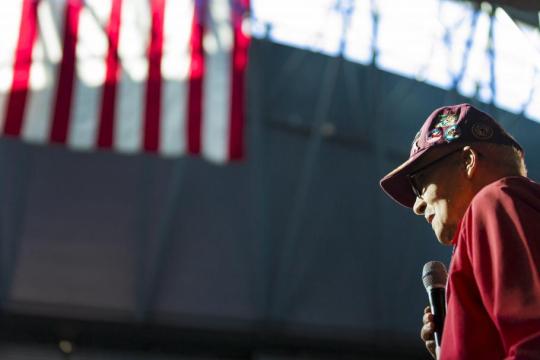
Brig. Gen. Charles McGee speaks to a group of visitors at the Steven F. Udvar-Hazy Center.
Born in Chicago in 1919, McGee spent his formative years as an Eagle Scout and worked for the Civilian Conservation Corps before studying engineering at the University of Illinois, where he also participated in the ROTC program. On his 22nd birthday, Japanese aircraft bombed Pearl Harbor, and the next day American officially entered World War II. After hearing of the US Army Air Corps’ new program to allow African Americans to train as combat pilots, McGee enlisted. Before leaving for training, McGee married his partner, Frances Nelson. Two days after their ceremony, McGee received his orders and became an aviation cadet.
McGee had experienced discrimination where he grew up in the northern United States, but noted that in Alabama, where Tuskegee Air Field was located, the racism was much more blatant. “Back in those days, the city of Tuskegee was off limits, and the sheriff wasn’t a friend. You didn’t buy gas or walk down the street in certain areas,” McGee said. But flying lifted his spirits. Even his early training rides sometimes became spiritual experiences. “Flying up to 45,000 feet to watch the sun set and stars come out,” he said. “It makes you realize we human beings are just one small aspect in a mighty grand universe.”

Tuskegee Airman Charles McGee stands in front of his P-51 Mustang Kitten during World War II.
After earning his wings and 2nd Lieutenant’s commission in June 1943, McGee joined the 302nd Fighter Squadron, part of the racially segregated 332nd Fighter Group, one of the units of the Tuskegee Airmen during World War II. Stationed in Italy, McGee flew P-39 Airacobras, P-47 Thunderbolts, and P-51 Mustangs on attack missions and bomber escorts. On August 24, 1944, McGee was escorting a group of B-24 Liberator bombers over Czechoslovakia while flying his P-51, named Kitten, partially after his nickname for his wife and partially as a reference to his crew chief, who “kept that engine purring like a kitten.” A group of German fighters pounced on the bombers, and McGee engaged, chasing a Fw 190 into a dive before shooting it down.
McGee ended his combat time in World War II after 136 missions, and then became an instructor for the 477th Bombardment Group (Medium), a group of African Americans training to become B-25 Mitchell crews.
Despite his decorated service, McGee faced harsh discrimination upon returning home. “In Europe, I was Charles McGee,” he said. “When you came down the gangplank in America, it’s, ‘Oh, you’re black.’ It was blacks this way, whites that way.” Even when serving in the United States, McGee was forced to leave his family behind because African Americans were not allowed to buy or rent homes in the areas around the bases to which he was assigned.
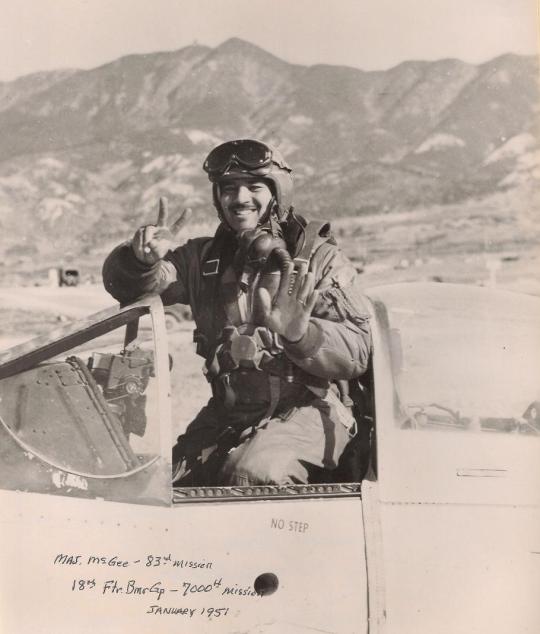
USAF pilot Charles McGee during the Korean War in 1951. McGee was a Tuskegee Airman during World War II and was promoted to Brigadier General in 2020.
When the Korean War began in 1950, McGee had recently become the base operations officer at Clark Field in the Philippines. He quickly joined the 67th Fighter Bomber Squadron and flew his favorite aircraft, the P-51 (now redesignated F-51) Mustang on 100 combat missions. After Korea, McGee held a number of command positions around the US Air Force, including commanding the 44th Fighter Bomber Squadron, flying F-80 Shooting Stars.
By 1967, with the Vietnam War increasing in intensity, the Air Force assigned McGee to command the 16th Tactical Reconnaissance Squadron at Tan Son Nhut Air Base in South Vietnam. Flying RF-4 Phantom II jet fighters on dangerous photo reconnaissance missions, McGee completed 172 combat missions and earned his first Legion of Merit.
After returning to several other leadership positions in the Air Force, McGee retired from service as a Colonel in 1973. With a total of 409 combat missions across three wars, he had earned the Legion of Merit twice, earned three Distinguished Flying Crosses, and was awarded a Bronze Star, among many other awards. After retirement, he went back to college to earn a degree and continued to serve in a variety of leadership positions, including the Boy Scouts, while helping to create and promote the Tuskegee Airmen Inc. He also made time to visit us at the National Air and Space Museum, signing books, speaking at family day programs, and participating in lectures. His willingness to share his story provided our visitors with a first-hand account of history, and many walked away moved by the change to hear from and speak to McGee.

Brig. Gen. Charles McGee stands on a stage during a family day at the Steven F. Udvar-Hazy Center.
In 2020, McGee received a promotion to Brigadier General. Then-Chief of Staff of the Air Force, General David Goldfein, noted the importance of recognizing McGee’s legacy: “Charles McGee is a genuine American hero whose courage in combat helped save a nation, and whose legacy is felt to this day across the entire US Air Force.”
Looking back, McGee and his fellow Tuskegee Airmen were a powerful force for change, helping to increase the effectiveness of the US military through a more equitable use of personnel—but McGee did not pursue his career out of a sense of advocacy. “It was more about wanting to do our best and accomplish the mission we were assigned,” he said. “We just wanted to be part of what the country was all about at the time. We could’ve said, ‘They don’t like us. They don’t want us’ and not served our country. We chose to serve, and it allowed our Air Force to see what we could accomplish, and ... bring about an important change in the country.”
@airandspace via X
10 notes
·
View notes
Text
Today's Black History Month illustration is of Benjamin O. Davis, Jr., the first Black general officer in the US Air Force and the commander of the 99th Flying Training Squadron, known as the Tuskegee Airmen.

Davis was born in 1912 in Washington DC, and his father, Benjamin O. Davis, Sr. was the first African American to become a general in any branch of the US military.

Davis studied at the University of Chicago until he received a recommendation to attend West Point from Rep. Oscar S. De Priest, the only Black congressman at that time. Davis entered West Point in 1932 and faced discrimination and racism because he was the first Black cadet to attend West Point in the 20th century and only the fourth to attend.
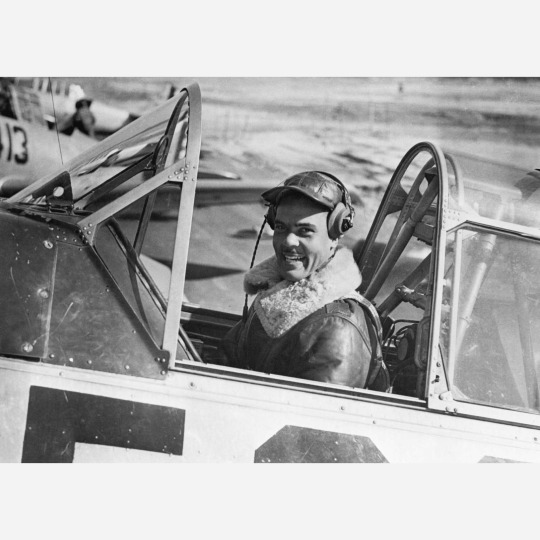
During his time there, he never had a roommate, he ate his meals in silence, and was only spoken to if needed. Despite being shunned, he graduated from West Point in 1936 at the top 20% of his class. After he graduated in 1936, he was commissioned in the infantry and in 1941 he was one of the first African Americans admitted to the Army Air Corps and to pilot training.
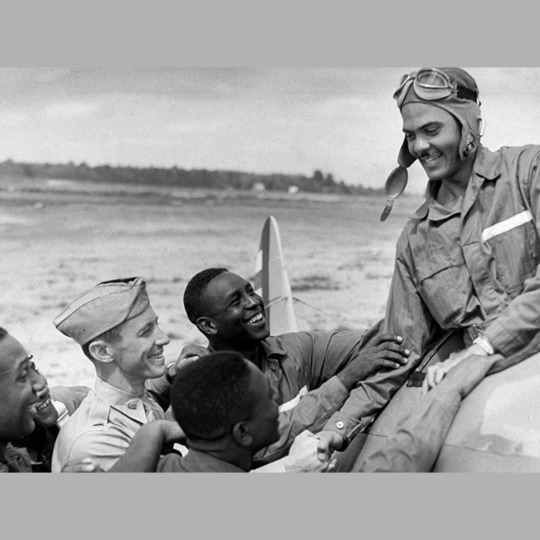
Davis was soon promoted to lieutenant colonel, and he organized the 99th Pursuit Squadron, the first Black air unit. In 1943, he organized and commanded the 332nd Fighter Group, also known as the Tuskegee Airmen. By the end of WWII, he had flown 60 combat missions.

After WWII, he helped plan the desegregation of the Air Force in 1948 and in 1954, he became its first Black general. He held progressively higher commands throughout his career, and he became lieutenant general before retiring from the Air Force in 1970.
In 1998, he was advanced to four-star general, making him a general of the highest order in the US military. He was the first African American to be awarded in retirement. (Side note: the propeller in the portrait background is from a P-47 Thunderbolt.)

I’ll be back tomorrow with another illustration and story!
#benjamin o davis jr#black history month#black history facts#black history month 2023#artists on tumblr#illustrators on tumblr
19 notes
·
View notes
Text

Tuskegee Airmen with the 15th Air Force, 332nd Fighter Group, 100th Flight Squadron
188 notes
·
View notes